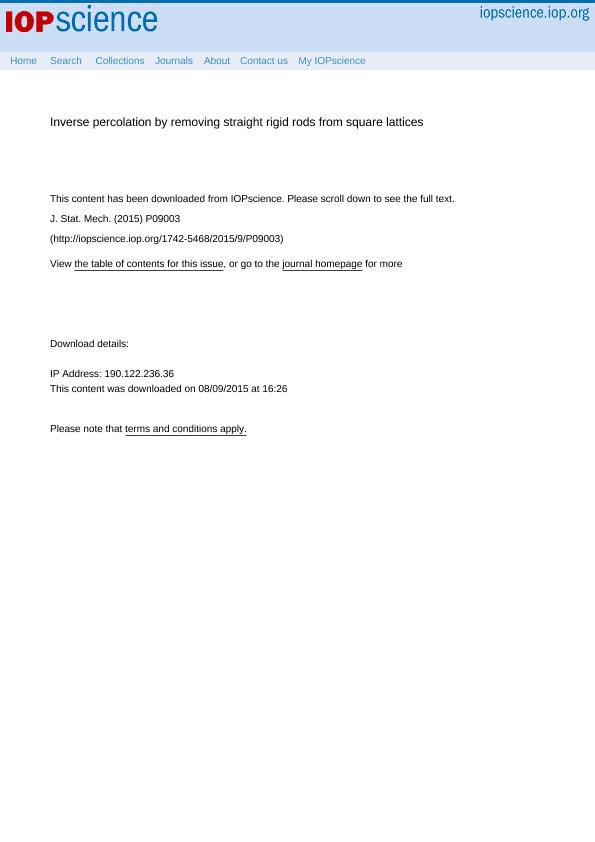Mostrar el registro sencillo del ítem
dc.contributor.author
Ramírez, Lucía Soledad

dc.contributor.author
Centres, Paulo Marcelo

dc.contributor.author
Ramirez Pastor, Antonio Jose

dc.date.available
2017-03-22T19:47:24Z
dc.date.issued
2015-09
dc.identifier.citation
Ramírez, Lucía Soledad; Centres, Paulo Marcelo; Ramirez Pastor, Antonio Jose; Inverse percolation by removing straight rigid rods from square lattices; Iop Publishing; Journal Of Statistical Mechanics: Theory And Experiment; 2015; 9-2015; 1-18
dc.identifier.issn
1742-5468
dc.identifier.uri
http://hdl.handle.net/11336/14205
dc.description.abstract
Numerical simulations and finite-size scaling analysis have beencarried out to study the problem of inverse percolation by removing straightrigid rods from square lattices. The process starts with an initial configuration, where all lattice sites are occupied and, obviously, the opposite sides of the lattice are connected by nearest-neighbor occupied sites. Then, the system is diluted by randomly removing straight rigid rods of length k (k-mers) from the surface. The central idea of this paper is based on finding the maximumconcentration of occupied sites (minimum concentration of holes) for whichconnectivity disappears. This particular value of concentration is called theinverse percolation threshold, and determines a well-defined geometrical phasetransition in the system. The results, obtained for k ranging from 2 to 256,showed a nonmonotonic size k dependence for the critical concentration,which rapidly decreases for small particle sizes (1 ⩽k ⩽3 ). Then, it growsfor k = 4, 5 and 6, goes through a maximum at k = 7, and finally decreasesagain and asymptotically converges towards a definite value for large valuesof k. Percolating and non-percolating phases extend to infinity in the space ofthe parameter k and, consequently, the model presents percolation transitionin all ranges of said value. This finding contrasts with the results obtainedin literature for a complementary problem, where straight rigid k-mers arerandomly and irreversibly deposited on a square lattice, and the percolationtransition only exists for values of k ranging between 1 and approximately1.2 × 10^4. The breaking of particle-hole symmetry, a distinctive characteristicof the k-mers statistics, is the source of this asymmetric behavior. Finally, the accurate determination of critical exponents reveals that the model belongs to the same universality class as random percolation regardless of the value of kconsidered.
dc.format
application/pdf
dc.language.iso
eng
dc.publisher
Iop Publishing

dc.rights
info:eu-repo/semantics/openAccess
dc.rights.uri
https://creativecommons.org/licenses/by-nc-sa/2.5/ar/
dc.subject
Classical Monte Carlo Simulations
dc.subject
Classical Phase Transitions (Theory)
dc.subject
Phase Diagrams (Theory)
dc.subject
Percolation Problems (Theory)
dc.subject.classification
Física de los Materiales Condensados

dc.subject.classification
Ciencias Físicas

dc.subject.classification
CIENCIAS NATURALES Y EXACTAS

dc.title
Inverse percolation by removing straight rigid rods from square lattices
dc.type
info:eu-repo/semantics/article
dc.type
info:ar-repo/semantics/artículo
dc.type
info:eu-repo/semantics/publishedVersion
dc.date.updated
2017-03-20T14:11:47Z
dc.journal.volume
2015
dc.journal.pagination
1-18
dc.journal.pais
Reino Unido

dc.journal.ciudad
Londres
dc.description.fil
Fil: Ramírez, Lucía Soledad. Consejo Nacional de Investigaciones Científicas y Técnicas. Centro Científico Tecnológico San Luis. Instituto de Física Aplicada; Argentina. Universidad Nacional de San Luis; Argentina
dc.description.fil
Fil: Centres, Paulo Marcelo. Consejo Nacional de Investigaciones Científicas y Técnicas. Centro Científico Tecnológico San Luis. Instituto de Física Aplicada; Argentina. Universidad Nacional de San Luis; Argentina
dc.description.fil
Fil: Ramirez Pastor, Antonio Jose. Consejo Nacional de Investigaciones Científicas y Técnicas. Centro Científico Tecnológico San Luis. Instituto de Física Aplicada; Argentina. Universidad Nacional de San Luis; Argentina
dc.journal.title
Journal Of Statistical Mechanics: Theory And Experiment

dc.relation.alternativeid
info:eu-repo/semantics/altIdentifier/url/http://iopscience.iop.org/article/10.1088/1742-5468/2015/09/P09003/meta
dc.relation.alternativeid
info:eu-repo/semantics/altIdentifier/doi/https://doi.org/10.1088/1742-5468/2015/09/P09003
Archivos asociados
